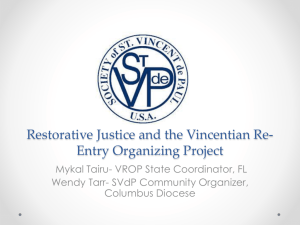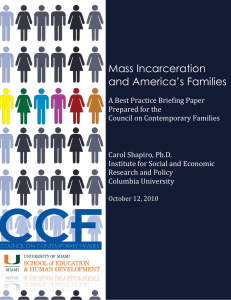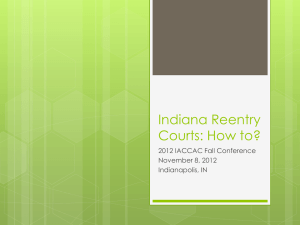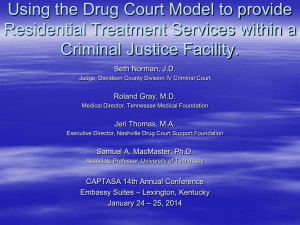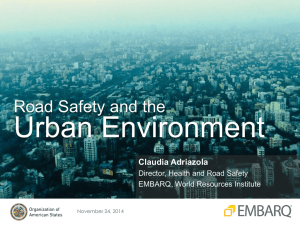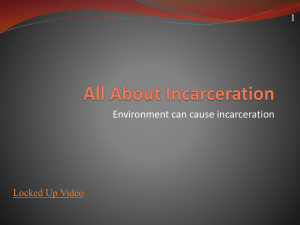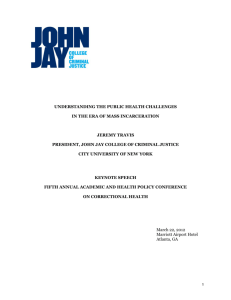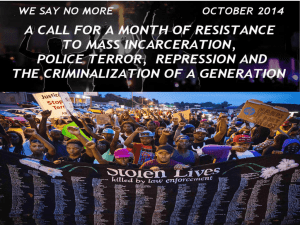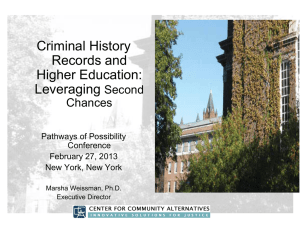United States
advertisement
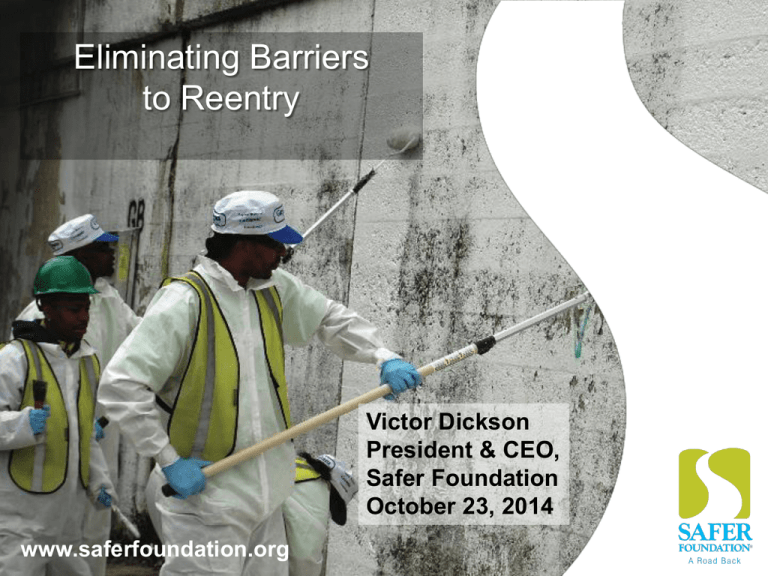
Eliminating Barriers to Reentry Victor Dickson President & CEO, Safer Foundation October 23, 2014 1 www.saferfoundation.org www.saferfoundation.org United States United States Total Population 318, 872, 000 # of Prison Facilities in Operation 4,575 (International Centre for Prison Studies) Total Capacity 2,265,000 (ICPS) Total People Incarcerated 2.29 million (2012 year end--BJS) Operating at 99% Capacity (ICPS) State Corrections Spending - $53.2 billion 2 www.saferfoundation.org Illinois (Location of the Majority of Safer Offices) Illinois Total Population 12,830,632 # of Prison Facilities 29 Total Capacity 32,075 (BJS) Total People Incarcerated 48,902 (IDOC October ‘14 quarterly report) Operating at 152% Capacity Corrections Spending - $1.2 billion 3 www.saferfoundation.org Barriers to Successful Reentry Individual —people returning from incarceration are not properly prepared to navigate life back in their home communities; beyond the myriad of preexisting issues consistent with most formerly incarcerated persons (e.g. little education and work history, substance abuse issues) the journey from prison to successful reintegration is often full of road blocks. Families —often families provide shelter and a safety net for people returning home, but frequently are struggling to meet their own needs & may be ill-prepared to address those of formerly incarcerated individuals. Systems— public (state, county, & city agencies) & private (service organizations) institutions have not been pro-active enough in coordinating efforts and support for this high-risk group of individuals. Without such support, public safety, community stability, & individual life outcomes remain at risk. Community—entire communities are not properly prepared to meet the complex needs of those returning home; the communities are weakened both by the individuals’ criminal activities & their ensuing absence due to incarceration, & then burdened by their return. 4 www.saferfoundation.org Personal Barriers to Reentry Employment Education Voting Mental Health Substance Abuse Financial Healthcare Transportation Legal 5 www.saferfoundation.org Housing Incarceration & Employment 6 • Unemployment Rate: 5.9% (Bureau of Labor, Sep. 2014) • “Black unemployment rate is consistently twice that of whites” (Pew Research Center, Aug. 2013) • The likelihood of a callback for an interview for an entry-level position drops off by 50 percent for those applicants with a criminal record (Professor Devah Pager’s, The Mark of a Criminal Record,” American Journal of Sociology 108(5), 2003: 937-975. 4) • More than one in four adults in the United States (70 million adults with arrests and convictions) have a criminal record that will show up on a routine criminal background check (National Employment Law Project: March 2011) • Employers had 4.84 million open positions in August 2014 (DOL) www.saferfoundation.org The Individual Financial Costs of Incarceration (Taken From the Pew Report “Collateral Costs”) • Two-thirds of male inmates were employed prior to incarceration • Incarceration, above and beyond arrest and conviction, has the most negative impact on an individual’s economic prospects post release • Serving time reduces hourly wages for men by approximately 11%, annual employment by 9 weeks, and annual earnings by 40% • Family income averaged over the years a father is incarcerated is 22% lower than the family income was pre-incarceration. In the year after the father’s release, family income remains 15% lower than it was in the year before incarceration 7 www.saferfoundation.org About Safer Safer Foundation, a not-for-profit organization headquartered in Chicago, is in its 42nd year. Our mission is to support, through a full spectrum of services, the efforts of people with criminal records to become employed, law-abiding members of the community and a result, reduce recidivism. Our vision is that all people with criminal records will have an equal employment opportunity. 8 locations in Illinois and 3 in Iowa More than 250 employees on staff A 63% reduction in recidivism rates with clients achieving 30 days of employment Over 4,200 job starts in FY13 $21 million budget in FY 14 8 www.saferfoundation.org Davenport Direct Services Direct Services Post-Release CommunityBased Adult Services Employment Readiness & Placement Basic Skills/GED Assessment Case Management Support Supportive Services Community-Based Services Faith-Based: PRI Youth Services 8-Week Sessions Basic Skills/GED Peer Teaching Methodology Case Management Employment Services Life Counseling President’s Reentry Initiative 9 www.saferfoundation.org Secured Community-Based Adult Transition Centers Outside Employment Job Preparedness Life Skills Community Service Education Case Management Mental Health Services Family Support Services Substance Abuse Treatment Secured Institutional State Prison County Jail PACE Institute Safer Return inside all state prisons Page 6 EMPLOYMENT PROGRAMS RETENTION SERVICES MODEL: AN INTEGRATED FRAMEWORK Finding Employment Preparing for Employment Group Orientation Job Ready Pathway Intake and Assessment Mental Health Substance Abuse Career Scope BESI >7.0 TABE >6 Months consecutive work experience Group 1: No credentials Group 2: GED and/or vocational credential Keeping Employment Retention Groups Industry Sectors Job Readiness Training If <1 yr of work Career Planning Workshops Candidate Pool/Job Search If>1 yr of work Pathway Placement Transitional Employment Pathway On the Job Groups If in Transitional Employment <7.0 TABE <6 Months consecutive work experience Supportive Services Pathway Services heavily front-end loaded towards retention 10 www.saferfoundation.org Make needed referrals; monitor services to meet required thresholds Refer to Pathway Job Bank Service Industries Manufacturing Construction Transportation/ Warehousing/ Logistics Other Sector Strategies Safer’s Collaborations Safer has fostered several partnerships over the years that have proved fruitful in achieving our on-going mission. Safer’s Partners Include: Policing, Courts, Jails & Prisons Elected Officials Government Agencies – Federal, State & Local Legal Aid Clinics Human Service Organizations Advocacy Groups Academic and Research Institutions Faith-based Organizations Philanthropic Institutions Businesses Individuals 11 www.saferfoundation.org . 3-Year Recidivism Results IDOC Recidivism Rate: 47.0% (FY2011 Releases) 63% Reduction 12 www.saferfoundation.org Results COST DIFFERENTIAL 45000 $38,268* 40000 Safer 35000 30000 25000 20000 15000 10000 5000 Safer Foundation’s Cost to Place Clients through Currently Funded Programs $3,200 0 *According to Vera Institute of Justice 13 www.saferfoundation.org IDOC Illinois Department of Correction’s Cost to Incarcerate Employer’s Cost to Use Safer $ Results IF PEOPLE GET JOBS Use Safer Photo Businesses have employees who contribute and are appreciative Lower turnover rate Fewer victims of crime Tax base goes up Taxpayer burden goes down Families work toward a better future Those connected to their families are less likely to commit crimes 14 www.saferfoundation.org What you should to know? • Poverty, Unemployment & Low Educational Achievement drive criminality • Lawyers (Legislators, Prosecutors, Judges) drive criminalization of behavior, punishment & barriers to reentry • Historical systemic discrimination in the US has always been legal (Slavery Era, Jim Crow Era, Mass Incarceration Era) 15 www.saferfoundation.org What can you do? • Advocate for Criminal Justice Reform in your state; laws, sentences, incarceration rates. • Advocate for elimination of legal barriers to employment. • Advocate for greater investment in reentry programs & services 16 www.saferfoundation.org What can you do? • Connect reentering citizens to institutions with access to the breadth of services needed. • Hire reentering citizens 17 www.saferfoundation.org Questions www.saferfoundation.org ?
